The Sonoran Blue is a small butterfly, but it leaves a mighty impression on those who see it in flight. Its combination of pale blue and vibrant orange is visually stunning; Bay Area lepidopterist Liam O’Brien likens it to “electric blue tinfoil.”
Actually spotting a Sonoran Blue (Philotes sonorensis), however, can be difficult, and not just because of its one-inch wingspan. Sonoran Blues only inhabit a few specific areas along the coast from the Bay Area to Baja, places where they host on dudleya (succulents in the Dudleya genus). Sonoran Blues emerge as adults to fly for a few weeks a year, sometime near the end of winter through the beginning of spring.
Following an unprecedented winter heat wave in February, the Sonoran Blues arrived early this year. The first week in February saw temperatures in the high 70s across the entire Bay Area, uncomfortable or anxious weather for humans expecting it to be winter but just right for a small insect looking to find a partner and start a family. So as San Jose set daily high temperature records, O’Brien, California Center for Natural History naturalist Tony Iwane, and USF architecture professor and amateur naturalist Cat Chang went looking for the blues at Alum Rock Park, one of the best Bay Area locations to find the elusive butterfly.
The butterfly Iwane photographed here is male, identifiable by a lack of red or orange spots on the hind wing. It was a perfect day to photograph butterflies, Iwane says, warm enough for the males to be in flight but cool enough that they needed to stop and rest their wings, as this one was doing. Once they’re aloft males spend most of their short lives searching for female Sonoran Blues, which tend to stick closer to the ground near dudleya plants.
After mating, the female Sonoran Blue lays a single egg on a dudleya leaf. The caterpillar that hatches bores into and lives inside the plant, where it has a symbiotic relationship with the stink ant, Tapinoma sessile. The stink ant guards the caterpillar from pests, and the Sonoran Blue provides food for the stink ant on the leaves in the form of deposited honeydew.
Sonoran Blues are generally described as “intensely local,” meaning that while their overall range is large they are only to be found in very small pockets within it. A subspecies on the San Gabriel River went extinct when its habitat was destroyed in 1968. But where their habitat is preserved the butterflies still fly on warm days in the season we used to label winter.





